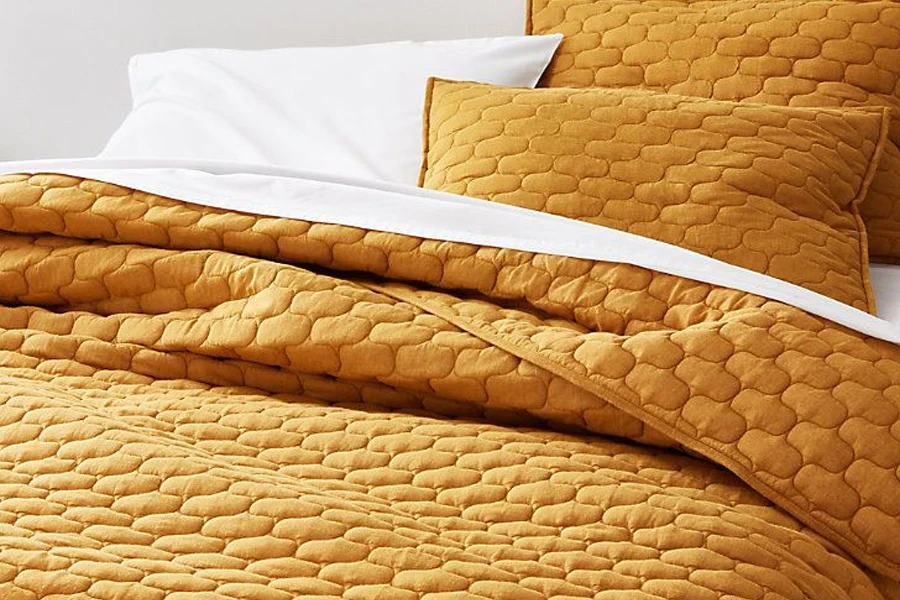In the quest for serene slumber and stylish bedrooms, selecting the ideal quilt becomes more than a mere bedding choice; it’s an embrace of comfort and a reflection of personal taste. As 2024 unfurls, the quilt industry is witnessing a vibrant transformation, marked by innovative designs and diverse materials tailored to enhance sleep quality and aesthetic appeal. This evolution in quilts ranges from eco-friendly fabrics, such as organic cotton and Tencel, to technologically advanced options offering enhanced temperature regulation. The trend towards personalized quilting styles and materials not only caters to varied climatic needs but also resonates with contemporary home decor trends. Thus, picking the right quilt in 2024 is a delightful convergence of functionality, fashion, and environmental consciousness, ensuring every rest is wrapped in comfort and style.
Table of Contents:
1. Market overview
2. Different types and their features
3. Things to consider when selecting products
1. Market overview
The quilt market is experiencing rapid expansion, capturing the interest of global investors and key industry players. According to Precision Business Analysis, the global quilt market, valued at 231253 million USD in 2019, is projected to reach 311677 million USD by 2025, demonstrating an impressive CAGR of 5.1% during 2020-2025. This growth trajectory is indicative of the quilt market’s dynamic nature and the increasing consumer demand for quality bedding solutions.

In North America, particularly the United States, the quilt market plays a pivotal role and is expected to see substantial growth throughout the forecast period. The adoption of advanced technologies and the presence of significant market players contribute to this regional market’s expansion. Europe also shows promising growth, with a remarkable increase in CAGR projected during the period 2022-2029.
The market is characterized by a variety of products, including cotton, flannel, cotton/poly blends, linen, and silk quilts, catering to diverse consumer needs. The rising demand in both residential and commercial sectors significantly drives the market’s growth. Technological advancements in quilt manufacturing and design are expected to further enhance product performance, making quilts more appealing for broader application.

This robust market growth, coupled with evolving consumer behavior and increasing market dynamics, presents a fertile ground for businesses and investors in the quilt industry. The continued optimism among investors, despite intense competition, suggests a strong recovery trend and the likelihood of new investments in the future.
2. Different types and their features
In the diverse world of quilts, various types cater to specific needs and preferences, each with its unique features and benefits.

Cotton quilts: Cotton quilts, renowned for their breathability and comfort, are an excellent choice for varied climates. According to Real Simple, these quilts are made from a fabric that is not only skin-friendly but also easy to clean, making them a practical option for everyday use. Ideal for warmer nights, cotton’s light and breathable nature ensures a comfortable sleep without overheating. The versatility of cotton quilts allows them to adapt to different temperatures, offering sufficient warmth on cooler nights while remaining cool during warmer seasons.
Wool and down quilts: For those in colder environments, wool and down quilts are the go-to options. Wool, known for its natural flame-retardant properties, is both warm and breathable. As highlighted by Blue Dahlia, wool quilts effectively regulate body temperature and humidity, making them perfect for chilly nights. Down quilts, on the other hand, trap air within their filaments, reflecting body heat for superior warmth. Despite their lightness, down quilts provide excellent insulation, making them a luxurious option for winter bedding.
Tencel and linen quilts: Tencel and linen quilts are a boon for hot sleepers. Tencel, a fabric recognized for its moisture-wicking and antibacterial properties, is ideal for those who seek a cooler sleeping experience. Linen, made from flax, shares similar qualities. It’s not only breathable and sweat-wicking but also temperature-regulating. According to NBC News, these materials are particularly suitable for summer, providing a cool and comfortable sleep without sacrificing style.

Synthetic fiber quilts: For those prioritizing affordability and ease of maintenance, synthetic fiber quilts like microfiber options are an excellent choice. These quilts offer the softness and lightweight properties needed for comfortable sleep, especially in warmer climates. The advantage of synthetic quilts lies in their durability and ease of care – they are often more resistant to frequent washing and less prone to wrinkling compared to their natural counterparts.
Artisan and hand-stitched quilts: Artisan and hand-stitched quilts bring a unique aesthetic and value to the bedding world. Each quilt is a work of art, showcasing intricate designs and craftsmanship. These quilts often tell a story, reflecting the culture and traditions of their makers. As per Blue Dahlia, the choice of fabric, color, and design in hand-stitched quilts adds a personal touch to home décor, making these quilts much more than just a bedding item – they are heirlooms to be cherished over generations.
3. Things to consider when selecting products
Choosing the right quilt involves a thoughtful consideration of material quality, sleep preferences, design, care requirements, and budget. By taking into account these factors, you can select a quilt that not only enhances your sleep experience but also reflects your personal style and values.

Material quality: The choice of material is paramount in quilt selection. Opting for high-quality materials like organic cotton and certified linens, as recommended by Blue Dahlia, ensures the quilt is safe, allergen-free, and environmentally friendly. Organic cotton is known for its softness and breathability, making it an excellent choice for sensitive skin. Certified linens, often recognized for their sustainability, offer durability and a unique aesthetic appeal. These materials, while being comfortable, also align with eco-conscious values.
Sleep preferences: Quilts should be chosen based on individual sleep needs. For instance, NBC News points out the importance of temperature regulation for a good night’s sleep. If you tend to sleep hot, a lightweight linen or Tencel quilt might be ideal. For those prone to allergies, quilts with hypoallergenic properties, such as organic cotton, are advisable. Understanding your sleep habits and health needs is crucial in selecting the right quilt type.
Design and style: The design and style of a quilt significantly contribute to the overall ambiance of your bedroom. As per Real Simple, quilts come in an array of designs, from traditional patterns to contemporary styles. When choosing a quilt, consider how it complements your existing home décor and personal style. Whether you prefer bold colors, subtle tones, or artistic patterns, the right quilt can serve as a statement piece or a harmonious addition to your bedroom.

Care and maintenance: Maintaining the quality and appearance of quilts over time is important. The durability and ease of maintenance depend largely on the material and craftsmanship. Some quilts are machine-washable, making them more convenient for regular use, while others might require more delicate handling. Understanding the care requirements of your quilt will help prolong its life and preserve its beauty.
Budget considerations: Balancing quality and affordability is essential when selecting a quilt. While higher-priced options often indicate superior quality and longevity, there are budget-friendly choices that do not compromise on comfort or style. It’s possible to find quilts that offer both quality and affordability, ensuring that you don’t have to sacrifice one for the other.
Conclusion
In selecting the best quilts for 2024, it’s essential to navigate through a diverse array of choices, keeping in mind the pivotal aspects of material quality, sleep preferences, design and style, care and maintenance, and budget considerations. From the breathable comfort of cotton and the luxurious warmth of wool and down, to the innovative cooling properties of Tencel and linen, and the affordability of synthetic fibers, each quilt type offers distinct benefits. The artisan and hand-stitched quilts add an extra layer of uniqueness, infusing personal style and cultural heritage into our bedding choices.




